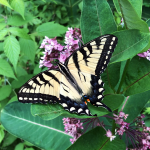Gardens
Garlic Mustard and Oriental Bittersweet | Garden Solutions for Invasive Plants
The trees in the area next to my yard have been overrun by vines, and the ground is covered with evergreen undergrowth. The vines still have some orange berries from fall; the lower plants were topped with white flowerheads last spring. What can I do to save my woods? J.F., Worcester, MA Invasive plant species […]

Coffee By Design | Portland, Maine
Photo Credit : Katherine Keenan The trees in the area next to my yard have been overrun by vines, and the ground is covered with evergreen undergrowth. The vines still have some orange berries from fall; the lower plants were topped with white flowerheads last spring. What can I do to save my woods?
J.F., Worcester, MA
Invasive plant species are dominating natural areas more and more. Fortunately, the two you describe are relatively easy to manage. The vine is Oriental bittersweet (Celastrus orbiculatus); the groundcover is garlic mustard (Alliaria petiolata). Both plants thrive in shady areas, spread rapidly, and choke out desirable plants. From late fall through early spring, these two “bad guys” are easy to identify because they stand out from other plants. Winter is an ideal time to control them.
Pull the bittersweet vines off the trees and follow them to the ground where they’re rooted. If the soil isn’t frozen, pull up the roots, following the orange pieces until they’re lifted from the ground.
If the earth is frozen, snip the stem low and carefully apply a poison ivy or brush control formulation (ask at your local garden center) to each cut stem. Then watch for any seedlings that may germinate each year and pull them up while they’re small.
Garlic mustard is a biennial, growing foliage the first year, producing flowers and seeds the next. In early winter, its first-year evergreen foliage is easy to spot against the otherwise-bare landscape. To control it most effectively, you’ll need a targeted chemical-management program combined with physical removal.
In early winter, apply a Roundup-type contact herbicide, coating all the leaves. Over the winter, the plants will absorb the chemical and die; next spring, you’ll have to pull up only the growth the spray missed.
Make sure you remove every surviving plant early in the season, before they can produce flowers and seeds. (Each plant can generate hundreds of new seedlings.) Seeds already in the soil are viable for several years, so plan on repeating this process each winter until you see no more germination.
Generally, I like to rely on natural, low-input lawn and garden maintenance around my home — but invasive plants present unusual challenges. You’ll actually manage many such species more successfully, and often with less damage to the environment, with chemicals, if you use them properly.
Remember to do your homework beforehand: Understand the target you want to control, consult expert sources for possible alternatives, learn how the chemical product works, and evaluate the risks and benefits.
— R. Wayne Mezitt, Chairman, Weston Nurseries, Hopkinton, MA
The trees in the area next to my yard have been overrun by vines, and the ground is covered with evergreen undergrowth. The vines still have some orange berries from fall; the lower plants were topped with white flowerheads last spring. What can I do to save my woods?
J.F., Worcester, MA
Invasive plant species are dominating natural areas more and more. Fortunately, the two you describe are relatively easy to manage. The vine is Oriental bittersweet (Celastrus orbiculatus); the groundcover is garlic mustard (Alliaria petiolata). Both plants thrive in shady areas, spread rapidly, and choke out desirable plants. From late fall through early spring, these two “bad guys” are easy to identify because they stand out from other plants. Winter is an ideal time to control them.
Pull the bittersweet vines off the trees and follow them to the ground where they’re rooted. If the soil isn’t frozen, pull up the roots, following the orange pieces until they’re lifted from the ground.
If the earth is frozen, snip the stem low and carefully apply a poison ivy or brush control formulation (ask at your local garden center) to each cut stem. Then watch for any seedlings that may germinate each year and pull them up while they’re small.
Garlic mustard is a biennial, growing foliage the first year, producing flowers and seeds the next. In early winter, its first-year evergreen foliage is easy to spot against the otherwise-bare landscape. To control it most effectively, you’ll need a targeted chemical-management program combined with physical removal.
In early winter, apply a Roundup-type contact herbicide, coating all the leaves. Over the winter, the plants will absorb the chemical and die; next spring, you’ll have to pull up only the growth the spray missed.
Make sure you remove every surviving plant early in the season, before they can produce flowers and seeds. (Each plant can generate hundreds of new seedlings.) Seeds already in the soil are viable for several years, so plan on repeating this process each winter until you see no more germination.
Generally, I like to rely on natural, low-input lawn and garden maintenance around my home — but invasive plants present unusual challenges. You’ll actually manage many such species more successfully, and often with less damage to the environment, with chemicals, if you use them properly.
Remember to do your homework beforehand: Understand the target you want to control, consult expert sources for possible alternatives, learn how the chemical product works, and evaluate the risks and benefits.
— R. Wayne Mezitt, Chairman, Weston Nurseries, Hopkinton, MA







